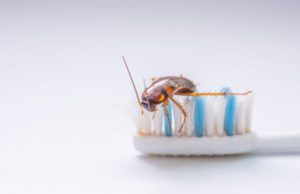REMINDER: COCKROACHES CAN SPREAD DISEASES TO PEOPLE
By Zachary Ciras on April 7, 2021.
A recent online forum had a question relayed by a pest control technician. In one of his accounts, the staff veterinarian wanted to know if the cockroaches in residence in one room of an animal research facility could transmit parasitic pinworms to animals in another room. The answer is “yes” they could if the cockroaches are carrying pinworms or their eggs and if they have access to that other room.
COCKROACHES ARE MECHANICAL VECTORS
Cockroaches are notorious and well-known transmitters of a long list of diseases and parasites. They carry the organisms in or on their bodies without being affected and can then “mechanically” transfer these organisms to other animals and humans. Mechanical transmission means the cockroaches are not biting or directly injecting the disease organisms as a mosquito would, but are instead transmitting them by contaminating food or surfaces which are then contacted by other animals or people. House flies spread disease in much the same manner.
Think about the places that cockroaches frequent and the contaminants that they can pick up on their mouthparts, feet (tarsi), and legs. Often disease organisms or parasite eggs are accidentally ingested by the roaches while eating or during grooming and are then excreted in their feces. See Can Cockroaches Really Spread Diseases?

Close up Cockroach on Toothbrush, carriers of pathogens to humans.
There’s little doubt that cockroaches contribute to cases of gastroenteritis, better known as food poisoning and often caused by Salmonella or other bacteria. The risk is greatest when you combine cockroaches with unsanitary conditions in food storage or preparation. When the feces of cockroaches contaminated with Salmonella come into contact with food or food prep surfaces, the results for people eating the food can be uncomfortable, at the very least.
PINWORM PARASITES ARE ANOTHER EXAMPLE
Pinworms are parasitic nematodes that are fairly common in young children and cause anal itching and restless sleep. Children get pinworms when they accidentally swallow or inhale the microscopic eggs. Anal scratching can result in eggs being transferred to surfaces or other people.
A recent Japanese survey of 320 German cockroaches (our most common species here in the Northeast) collected in 79 restaurants found that almost 67% of the roaches had parasitic pinworms present in their hindgut. Three different lines of laboratory-bred German cockroaches were also examined. Two of the three were found to be infected at 93% and 85%, respectively. The researchers also showed that uninfected cockroaches could be infected by exposure to cockroach feces containing pinworm eggs. (doi: 10.1292/jvms.20-0617)
SOME COCKROACHES LIVE AND EAT IN THE SEWER SYSTEM
Compared to some other cockroach species, our German cockroaches would almost seem to live a clean existence. German cockroaches are considered to be domestic cockroaches since they live almost entirely indoors and in close proximity to people. At least we know, somewhat, where they’ve been.
In comparison, other semi-domestic cockroaches such as the large American cockroach and the Oriental cockroach can maintain an outdoor/indoor existence, living sometimes almost entirely in storm drains or in the underground sewer system where human feces is always on the menu! A very scary thought now that we know that COVID-19 disease organisms can be detected in human feces.
LIVING WITH ROACHES IS NOT HEALTHY!
American cockroaches and other sewer roaches can and do enter homes and commercial buildings from sewer pipes. A common entry is through dry drains in tubs, toilets, slop sinks, and floor drains. Sewer roaches also end up in buildings when a primary sewer line backs up or through a break in a sewer pipe. See Yes, There Are Cockroaches in Your Sewer System!